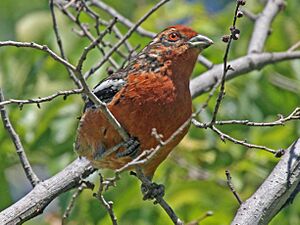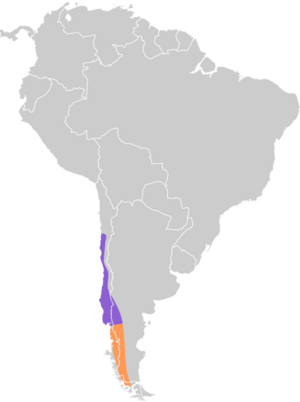Rufous-tailed plantcutter facts for kids
Quick facts for kids Rufous-tailed plantcutter |
|
|---|---|
 |
|
| Conservation status | |
| Scientific classification | |
| Genus: |
Phytotoma
|
| Species: |
rara
|
 |
|
The rufous-tailed plantcutter (Phytotoma rara) is a cool bird found in southern South America. People sometimes call it the Chilean plantcutter. It's a type of passerine bird, which means it's a perching bird. It belongs to the cotinga family.
This bird is about 19 centimetres (7.5 in) long, which is like the length of a small ruler. It has a long black tail with a splash of red at the bottom. Male plantcutters have grey-brown feathers on their back. They also have a pretty chestnut-colored cap on their head and chest. Their faces have dark markings. Female plantcutters look a bit similar. However, they don't have the chestnut cap. Their feathers underneath are streaked and buff-colored. Both males and females have a stripe on their wing. It's white on the male and buff on the female. This bird is quite common and lives in many places. Because of this, experts say it's a "least concern" species. This means it's not currently in danger.
Contents
What Does the Rufous-tailed Plantcutter Look Like?
The rufous-tailed plantcutter is a strong, stocky bird. It is about 18 to 20 centimeters long. It has short wings and bright red eyes. Its tail is quite long and black, with a reddish part near its body.
Male birds have grey-brown feathers on their upper body. These feathers also have dark streaks. Their head and chest are a rich chestnut color. They have a white stripe on their wing. Their face has a cool pattern of dark and light areas.
Female birds have buff-colored feathers on their underside. These feathers have brown streaks. Their wings have buff, not white, stripes. They don't have the chestnut cap like the males. But sometimes, their forehead and throat might have a cinnamon color.
How Does it Sing?
The song of this bird sounds like a series of quick, stuttering notes. After that, it makes a rough, rasping sound. Some people say it sounds like a fishing reel when you wind it in!
What Does it Eat?
This bird has a special beak that looks a bit like a finch's beak. It's short and thick, and it has serrated (saw-like) edges. The bird uses this special beak to strip off buds, leaves, and fruits from plants. Sometimes, they also eat insects. They feed insects to their baby chicks.
Where Do They Live?
The rufous-tailed plantcutter lives further south than any other cotinga bird. You can find it in Chile and western Argentina. It likes to live in scrublands, the edges of forests, and river valleys.
Its home range stretches from the Magallanes area in the south of Chile, all the way north to the Atacama region. In Argentina, it lives from Santa Cruz north to Mendoza.
Do They Move Around?
Birds that live in the southern parts or high mountains move to warmer, lower areas in winter. This bird has even been seen by accident in the Falkland Islands. You might often spot these birds in gardens, on farms, and in fruit orchards. Sometimes, farmers think they are a bit of a pest because they eat crops.
Nesting and Eggs
The rufous-tailed plantcutter builds a cup-shaped nest. It uses root fibers and small twigs. The nest is usually placed in a fork of a shrub or a tree. The female bird lays two to four eggs. These eggs are blue-green with dark spots. The spots are usually more concentrated at the wider end of the egg.
Is the Rufous-tailed Plantcutter Safe?
This bird lives in a very large area. Even though you might not see huge numbers of them in one spot, there are many of them overall. Experts believe the number of these birds is staying steady. Because of its wide range and stable population, the International Union for Conservation of Nature says the bird's conservation status is "least concern". This means it's not in danger of disappearing.


